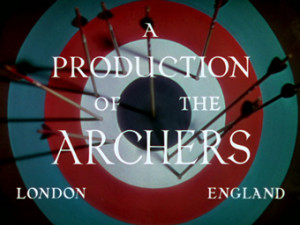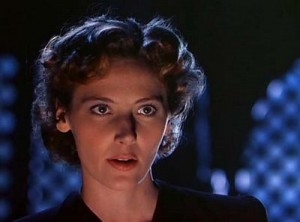
As far as I’m concerned, a chilly Sunday is the perfect day to stay indoors for a movie-marathon session while drinking hot chocolate. (Return to your workout tomorrow.) What better way to immerse yourself in a master filmmaker’s work? Today I suggest the sumptuously gorgeous movies of Michael Powell and Emeric Pressburger, aka The Archers.
Together Powell and Pressburger wrote, directed and produced 19 movies, of which many are considered masterpieces and influenced many great filmmakers, including Martin Scorsese.[*] Their films are characterized by a masterful use of color that heightens the story’s emotional thrust. There’s a dreamy, surrealistic quality to their work and the effect verges on the hallucinatory, especially when viewed on the big screen. If you’re looking for quiet, understated filmmaking, you’ve got the wrong team. This is melodrama at its most emotionally satisfying. As a woman, I also find the main characters in I Know Where I’m Going!, The Red Shoes and Black Narcissus interesting and compelling studies of women’s complex emotional world.
The Red Shoes
This is an adaptation of Hans Christian Andersen’s fairy tale of the same name and tells the story of a ballerina, her passion for her art, and her relationship with the Svengali-like head of her ballet company. This is one of the first movies to explore commitment to one’s art from a woman’s point of view and it inspired the dance movie. (This is the only genre in which a female character is allowed to put her work ahead of love without being punished for it.) Gene Kelly openly admitted its influence on his equally gorgeous An American in Paris. The movie is also a great example of how to handle “a story within a story” narrative structure. Watching it is a little bit like mainlining cinematic opium. I know that sound over the top, but watch it and tell me if you don’t come out a little dazed afterward, as if you’ve taken a very potent drug. In later interviews, Moira Shearer expressed scorn for the unrealistic way the movie handles the real struggles of a ballerina, but the film still resonates with me as an example of what it is like to be gripped by an artistic passion.
Black Narcissus

At first glance, the problems of a convent in the Himalayas might put off modern viewers. But if you brush aside any bad memories of late-night viewings of Sister Act, you’ll be rewarded. Black Narcissus is a melodrama with a dash of psychological thriller. Repressed desire and pathological jealousy rear their ugly heads, making for a gripping and visually arresting experience. This film is a lesson in training your directorial eye, particularly the climactic scenes at the end which remind me of sequences in Hitchcock’s Vertigo. (I won’t tell you which ones so I won’t spoil it for you.) It is also, needless to say, excellent training in writing a taut, emotionally surprising script. What I love about the Archers is that cinematic technique is always in service to the story, and although things might be over the top, they make perfect sense within the dramatic context of the movie. After all, the characters are isolated emotionally and physically from everything they know in a foreign and sensual setting, and their actions and reactions stem from those facts.
I Know Where I’m Going!
This one is in black and white and it is not usually included as one of their masterworks but it ranks as such with Martin Scorsese and the British film critic Barry Norman. It has a tight script whose female character is believable, human, and complicated. Like Black Narcissus, this is another example of Powell and Pressburger’s use of location as a secondary character. After all, places have as much of a personality as people, and can affect us just as much, sometimes more. The main character is a young woman whose ambition is to marry a rich older man. She travels to the Hebrides for the wedding, but her plans are derailed by the stormy weather. This is one of those movies that perfectly illustrates John Lennon’s philosophy that “life is what happens to you while you’re making other plans.” Made during the war, it’s also a prime example of how to make a great movie with scarce resources.
In fact, Scorsese was instrumental in restoring Michael Powell’s reputation after many years of obscurity and even in playing matchmaker between the venerable director and Thelma Schoonmaker, Scorsese’s longtime editor! BACK TO POST
